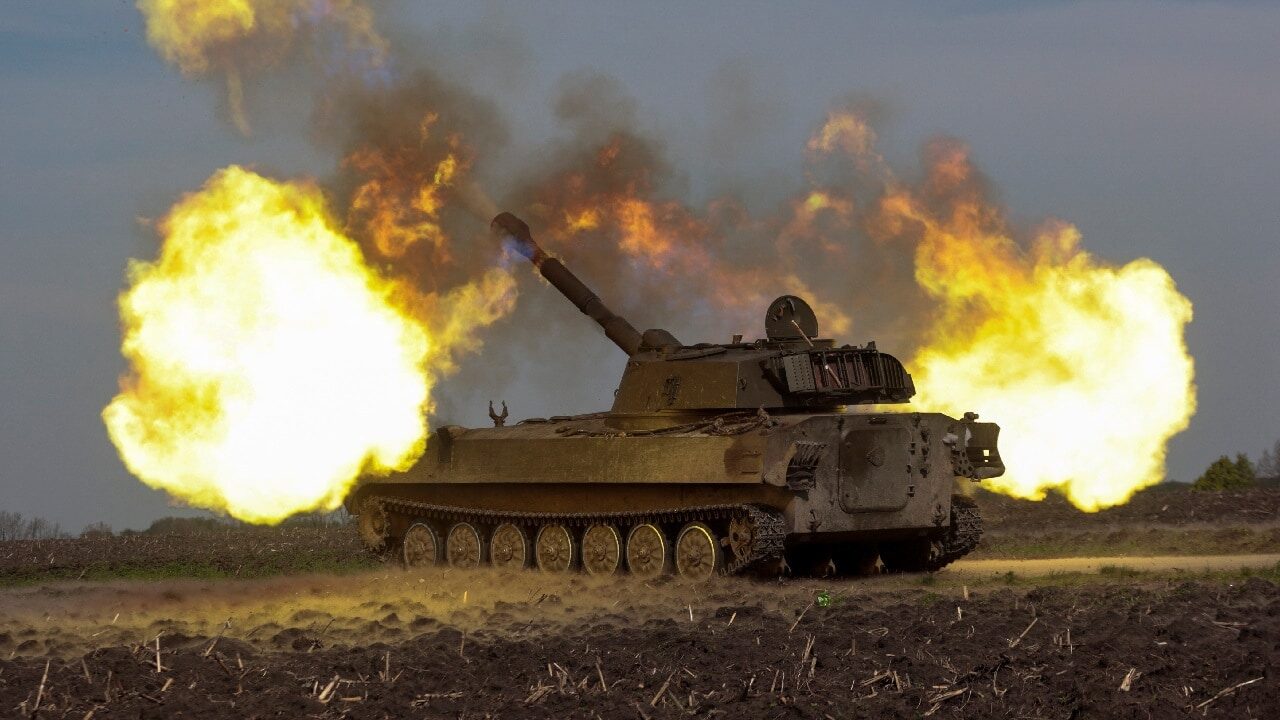The destruction of a Russian 2S1 Gvozdika 122mm self-propelled howitzer (SPH) could be seen in a video shared across social media on Thursday morning.
The artillery platform was taken out by Ukrainian artillery and could be a warning of a planned counteroffensive in the Kherson Oblast.
The 2S1 Gvozdika is one of the Soviet-era combat systems still employed worldwide.
It is in service with both the Russian and Ukrainian forces.
In a twist of irony, it was developed in Soviet Kharkiv (now in Ukraine) and is a fully amphibious vehicle that can be used to cross rivers, while it can be fitted with a variety of track widths to operate in snow or swamp conditions. It offered NBC (nuclear, biological, and chemical) protection for the crew.
According to the post from Ukraine Weapons Tracker (@UAWeapons), the strike on the Russian-operated 2S1 Gvorzdika self-propelled howitzer occurred on the left bank of the Dnipro River, which has largely remained under Russian control.
Ukraine Counteroffensive Coming?
Last November, Ukraine had successfully liberated the city of Kherson, which was heralded as a significant victory for Kyiv’s forces – as it left Russia holding none of the country’s largest cities. Moscow’s forces retreated across the river and instead began to bombard Kherson.
According to a recent report from the Institute for Study of War (ISW), Ukrainian forces have already established a number of beachheads across the Dnipro River, which could suggest that Ukraine may seek to take back more of the Kherson Oblast in the south of the country and above the Crimean peninsula.
Ukrainian forces may have been holding positions on the eastern bank (left bank) for several weeks and even had established stable supply lines to those positions.
However, much of that territory in the Kherson Oblast has been under Russian control since the early stages of the war, and the Kremlin’s forces have been reportedly digging in and fortifying their positions to fend off the expected counteroffensive.
Historical Significance
There is some noted historical significance to Russia’s positions on the “Left Bank.”
In 1667, Ukraine had been partitioned along the Dnipro (Dnieper) River. The western side, known as the “Right Bank,” was under Polish control – while Russia confirmed its position in the east.
The arrangement was confirmed in 1668 in the almost comically named “Treaty of Eternal Peace between Poland and Russia.“
#Ukraine: A Russian 2S1 Gvozdika 122mm self-propelled howitzer was destroyed by an Ukrainian artillery strike on the left bank of the Dnipro River, #Kherson Oblast. pic.twitter.com/5qWFeDC2BN
— ???????? Ukraine Weapons Tracker (@UAWeapons) April 27, 2023
It secured Russia’s possession of left-bank Ukraine along with the right-bank city of Kyiv (Kiev).
It could hardly be described as eternal or perpetual, however, as Russia later joined Austria and Prussia in partitioning Poland at the end of the 18th century. Independent Poland disappeared from the map until 1918, while Ukraine’s efforts to gain independence didn’t come to fruition until 1991.
It can be understood why taking back every inch of the occupied territory is a key war aim for Kyiv. Yet, Moscow seems to be taking everything that it can.
There have been reports that Moscow is now “forcibly evacuating” civilians from the Kherson Oblast, while Russian troops were also stealing as much as they can ahead of an expected Ukrainian attack.
Author Experience and Expertise
A Senior Editor for 19FortyFive, Peter Suciu is a Michigan-based writer. He has contributed to more than four dozen magazines, newspapers, and websites with over 3,200 published pieces over a twenty-year career in journalism. He regularly writes about military hardware, firearms history, cybersecurity, politics, and international affairs. Peter is also a Contributing Writer for Forbes and Clearance Jobs. You can follow him on Twitter: @PeterSuciu.

